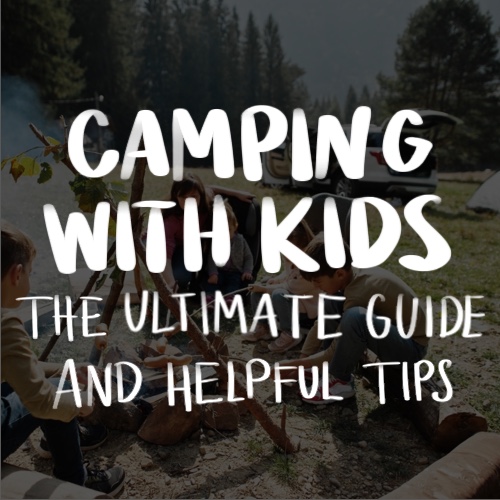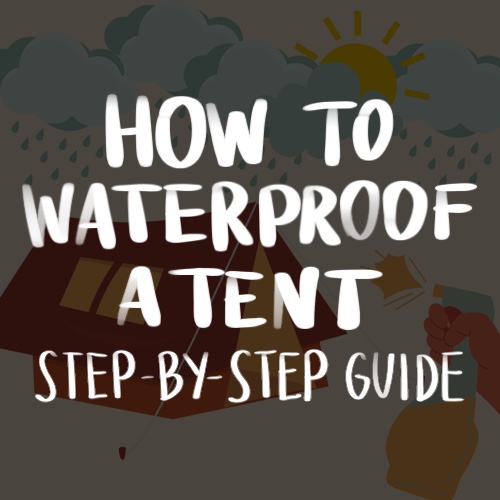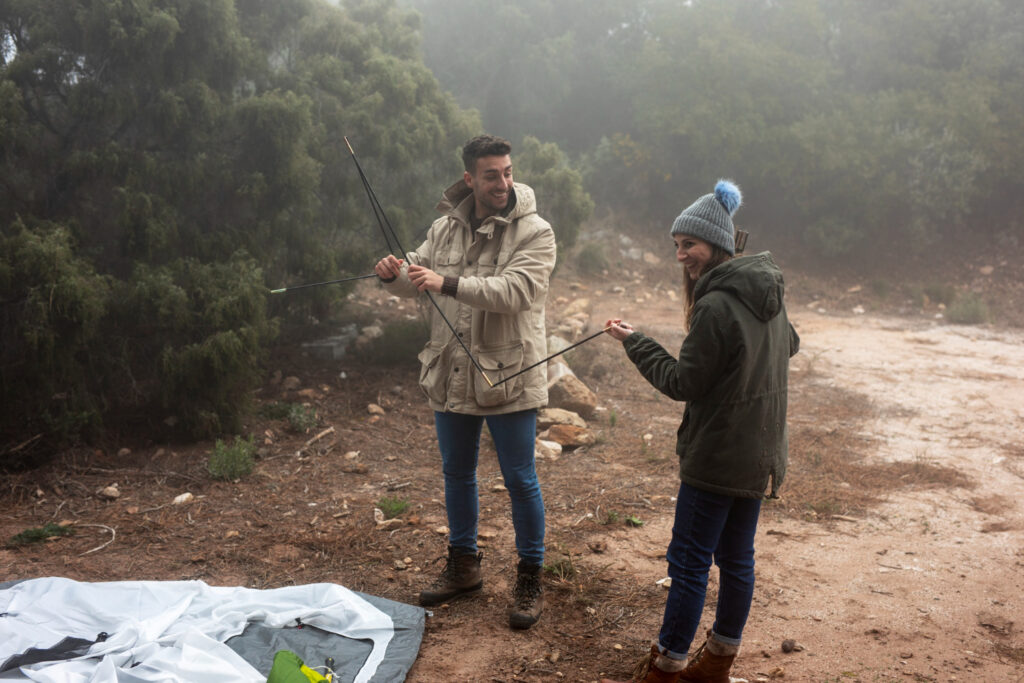
What if you plan your camping trip for weeks or months, only to wake up to rain pattering on your tent? It’s better than you think because you can make your camping trip meaningful differently. Even that annoying downpour hitting your tent could become a welcome sound as many activities fill your time.
With a bit of extra preparation and the right gear, you can have an unforgettable experience.
I have been camping for years and have already developed a good reputation for finding practical solutions for camping in the rain, whether in a tent, car camping, or outdoor activities.
So, you can make the most of your camping adventure with the tips and the essential answers I prepared for you.
Let’s get started!
Table of Contents
Before You Become Involved in Rainy Camping…
No matter how prepared you are for rainy camping, it’s likely that you’ll get wet, but that shouldn’t get you down.
Although I know you won’t spend all your time in the tent and will have to face the rain without wanting to, you will learn to embrace the inconvenience of camping in the rain. The key is to prepare appropriately to be able to embrace it.
First, you may ask yourself the following two questions:
Is it worth camping in the rain?
What to do when camping in the rain?
Is it Worth Camping in The Rain?
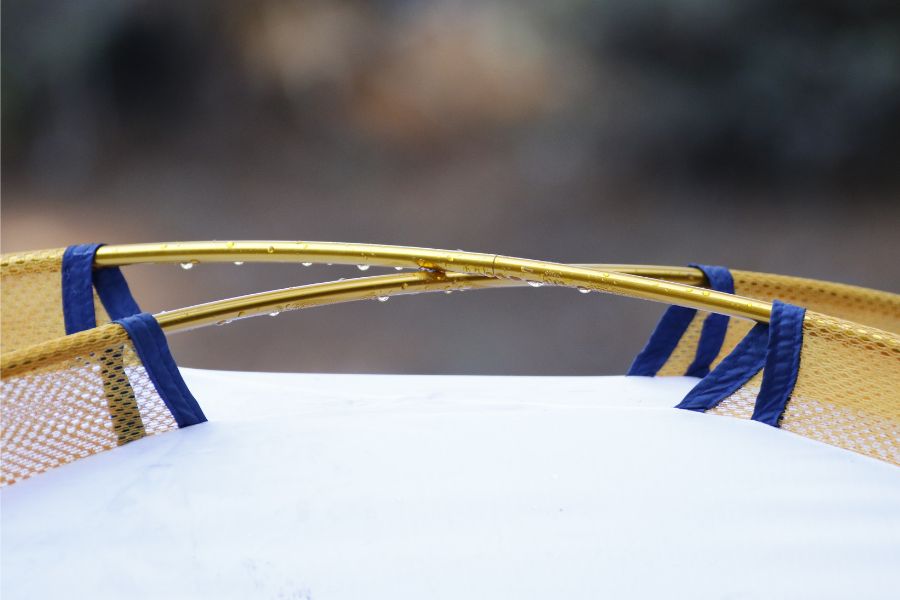
Camping in the rain can be a great experience, but it can also be challenging and tiring if you need more preparation.
As a precaution, check the weather forecast before camping and prepare on time.
Be sure to bring tarps, raincoats, and waterproof gear to protect yourself from the elements and equipment from getting wet. Either way, it could be an unpleasant experience!
But, to make it worthy, you must have the right gear.
Remember, after the rain comes a rainbow, and the world comes alive. So, be optimistic because something better is coming your way.
What To Do When Camping in The Rain?
Rain is often not pleasant, especially in nature. It can spoil your activities or camping if you don’t have rain gear. If you bring adequate clothing, footwear, and tent equipment to set up your campsite, your camping adventure will go smoothly.
Here’s exactly what to do and how to behave when it’s raining while camping:
Take cover if possible. Look for an awning or canopy to stay dry.
If you can’t find shelter immediately, try to get out of the rain as soon as possible.
If you are outside, wear a raincoat or other waterproof clothing.
Wear a hat and cover your head to protect yourself from the rain.
If you have umbrellas, use them.
Avoid carrying electrical equipment that you can damage in the rain.
Watch out for slippery surfaces caused by rain.
Watch out for flooding and other potential hazards
Check that water does not collect in awnings and canopies to prevent damage to structures and fabrics.
Close the windows and doors in the rain direction, but maintain some tent ventilation.
Keep wet camping gear in waterproof bags or plastic bags.
Check the likelihood of flooding in the low-lying camping area.
Protect firewood from moisture.
I will cover the essential things to consider when camping in the rain.
Rain Gear To Keep You Dry and Warm
The right camping rain gear is essential to protect and keep you dry. A good raincoat and waterproof pants are some of the must-have items you will bring to camp.
You already know the essentials, but let me explain clothing in more detail.
Take Adequate Clothing On Your Camping Trip
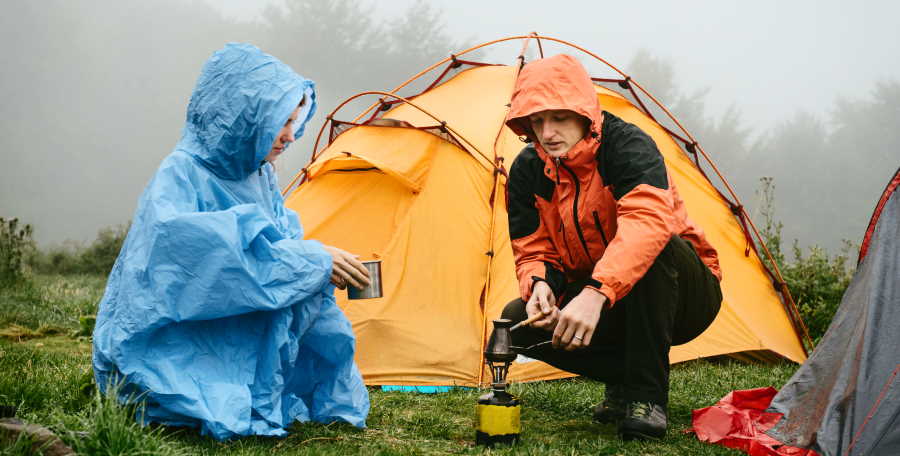
Having adequate clothing to prepare for camping in the rain is essential. Sometimes there can be so much humidity that it surprises you, and you don’t have dry clothes. Keep in mind that nature is sometimes unpredictable.
What if it rains heavily or if it lasts a long time? Well, you must equip yourself additionally.
So follow our few tips closely because we will explain what you must bring from home to enjoy your camping trip.
Adequate clothing for camping in the rain should include waterproof and breathable outer layers, such as a waterproof jacket, rain suit, waterproof trousers, rain pants, and a rain hat.
Underneath these layers, you should wear warm, insulating clothing layers, such as a synthetic base layer, a fleece mid-layer, and an insulating down or wool layer.
Wearing a pair of waterproof boots and gloves is also essential.
With these pieces of clothing, you’ll be ready to handle any wet weather you may encounter while camping.
Bring More Dry Clothes
In cold weather, especially when it’s raining, your body loses heat faster when wearing wet clothes, so it’s essential to bring extra clothes as a lifesaver at the right time.
Bring more dry clothes than usual, especially if camping for multiple days.
You may need to bring extra clothes, such as a jacket and raincoat, to keep you dry in a heavy downpour. With the right supplies, you can spend your time in the bath with peace of mind.
Avoid Cotton Clothing
Wearing cotton clothes in the rain is one of the worst things that can happen to you. Cotton absorbs moisture, so you’ll get wet and heavy from rain and sweat. You will dry more slowly, which can be inconvenient if you have to move around.
Instead, opt for clothing made from synthetic fabrics such as nylon or polyester, which are lightweight and keep you warm and dry in wet weather.
Bring Waterproof Shoes And Waterproof Backpacks
Imagine you are in the wilderness, it starts to rain heavily, and your shoes and backpack are wet. It’s not waterproof, so everything in your bag gets wet. You begin to feel anxious and increasingly nervous. You would feel powerless.
But let it be just an idea. With practice in the future, you will know how to keep your things dry. You will practice in time, so you will know that bringing waterproof shoes, backpacks, waterproof jackets, and daypacks will help you remain dry.
Investing in a quality backpack for camping in the rain is vital. It will prevent your supplies, such as clothing and electronics, from getting wet and ruined. It would help if you had high-quality hiking backpacks that are both durable and waterproof.
Waterproof shoes help keep your feet dry and comfortable, while waterproof backpacks protect your belongings from the rain. Wet feet can be uncomfortable and lead to blisters if you don’t have waterproof shoes.
They also protect your feet from mud and debris, so you can camp in wet weather without worrying about your feet.
Bring Hand Warmers
Hand warmers are a great way to keep warm during cold and rainy weather and provide instant warmth to your hands and body heat. You can easily carry them with you wherever you go.
Hand warmers are usually filled with a special gel or liquid and can be heated by shaking or clicking a button.
Apart from camping, they are also perfect for other outdoor activities, such as skiing or skating.
Take The Gaiters
Gaiters are well-known rain gear for hikers, so if you are planning outdoor activities or mountain climbing and want to protect your feet and shoes from moisture and mud, buy this waterproof cover without worrying about getting wet. You can visit a store gear where you can buy everything you need.
When wearing camping gaiters, ensure you use the correct size and check for tears or weak spots before using them.
Drying Out Wet Clothes
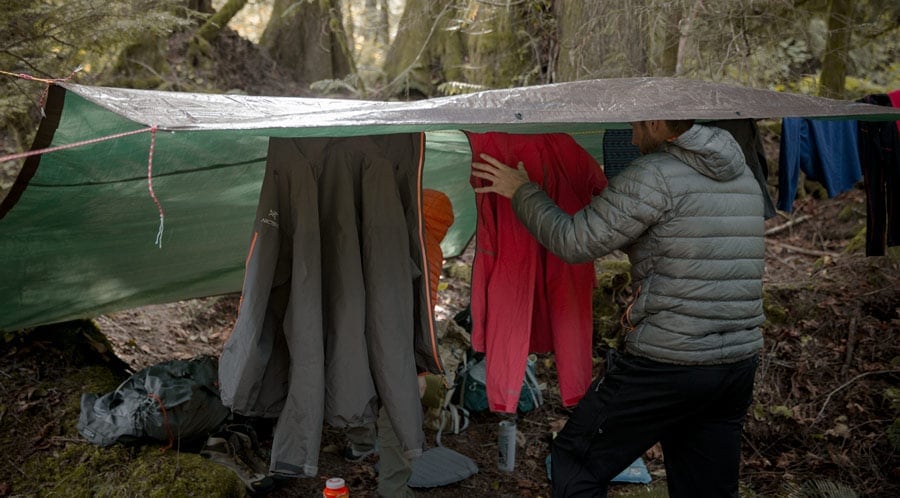
Whether you bring extra dry clothes from home, drying your wet clothes is just as important. The best way to do this is to hang wet gear in a covered area away from the rain, where it can still have air circulation.
One of the even better ideas is to start a campfire, as it is an excellent resource for providing warmth that will help speed up the drying process. However, keep wet equipment at a safe distance from the fire.
You can dry the equipment with a fan or other portable heating device.
When drying wet gear, the most important thing is to find a balance between heat and air circulation.
Now that you’re familiar with clothing, it’s time to explain what your campsite should look like, what kind of tent you should have and where you should set it up.
Your Camping Setup
Setting up and packing camp when camping in the rain can be challenging, but you can do it safely and successfully with the right supplies and preparation.
When setting up, it’s essential to ensure the tent is secure and waterproof and plan where your cooking and eating supplies will go.
Be sure to bring extra tarps or a rain fly for additional protection from the rain.
When packing, it’s essential to take your time and pack and seal everything to prevent water damage.
In addition, it is essential to use the waterproof bag and containers for any items that cannot get wet and check the campsite for any items that may have blown away during the storm.
Find The Right Tent Site
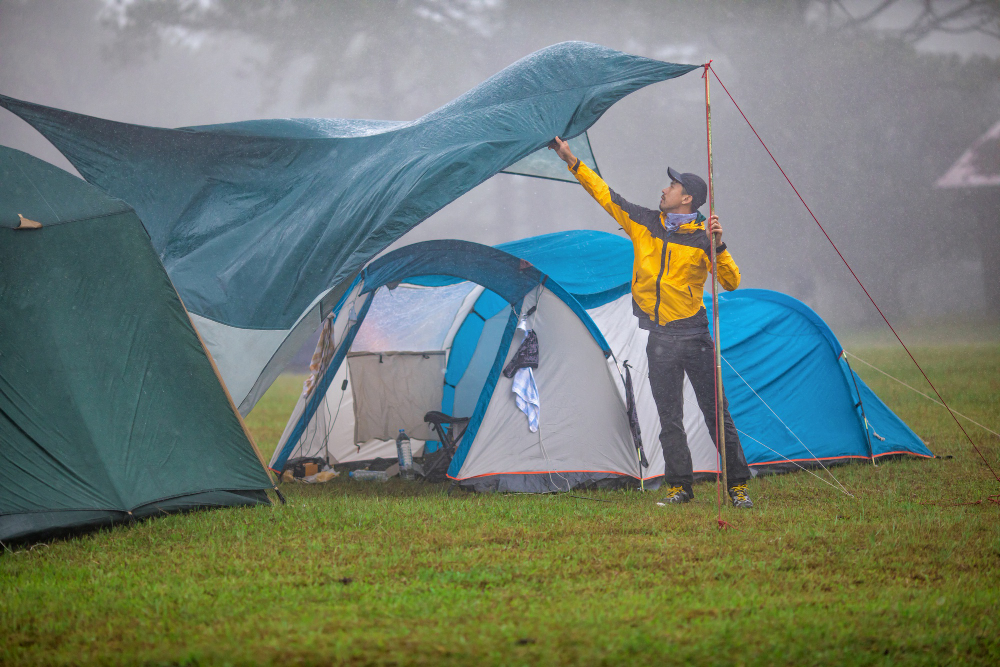
Your campsite must be suitable for camping in the rain. If you’ve ever been camping, finding the right place to pitch your tent is essential to a comfortable camping experience.
Start in reverse order by packing everything in the camper except your pop-up shelter, parking the car next to the trailer, and loading your camper. Park the car under cover while you unload the trunk.
There are a few key things to consider.
First, it is necessary to check the terrain. Is the land flat, or is it on a hill? If it is on a slope, choose a place that is not too steep.
Second, pay attention to the direction of the wind. If it’s too windy, pitching a tent and staying awake may be more affordable.
Third, be sure to choose a place where you have plenty of shade and protection from the sun.
Finally, be mindful of your surroundings. Try to camp away from busy paths and roads to ensure a quiet and comfortable night.
Also, I advise you to watch out for tree branches during heavy rainfall, which increases the risk of them falling, and to watch out for rising water if you’re camping next to a stream or river.
Pitch Your Tent On Higher Ground
Take the time to set up the tent as well as possible, as it will help keep you dry inside in case it rains.
It would help to pitch your tent on higher ground because the rain will run down and sit in the lowest part.
Pitching your tent on higher ground is essential for several reasons. Firstly, it will provide better rainwater drainage away from your tent and sleeping area.
Secondly, the higher ground can provide better air circulation, which will help keep the inside of your tent dry and comfortable.
Lastly, the higher ground can offer better protection from the elements, such as wind and cold temperatures.
Bring a Waterproof Tent
A tent is an integral part of camping equipment that will protect you during the rain. But you can assume that only a waterproof tent comes into play. Otherwise, moisture will quickly enter the inside of the wet tent.
Accept that you won’t have dry clothing if caught in a sudden downpour.
Waterproof tents are usually made of nylon and polyester and have a waterproof coating that prevents water from entering the tent. In addition, waterproof tents often come with a mat, which further increases the tent’s waterproofing and insulation that helps you stay warm.
If you don’t have a waterproof tent, remember that you can waterproof the tent yourself.
Bring a Rug For Your Tent Entry
Bringing a tent rug is a great idea when camping in the rain. First, you can use it to wipe off muddy and wet shoes and boots before entering the tent and provide extra cushioning for your wet feet when entering and exiting the tent.
The rug is made of waterproof material, such as polyester or nylon, so it does not become saturated with rainwater and creates a wet mess.
Avoid Collecting Water
A lot of water in your tent can permanently damage it, including the tent door and bottom.
To avoid water build-up:
Position the tent properly using all pegs and ropes, and tension the awnings properly and evenly to facilitate water runoff.
Only leave camp for extended periods if expecting rain, but once you have tested the tent in a downpour. Even though you think everything will be ok, water can be in unexpected places.
When it rains, lower the awning poles to increase the angle of water runoff.
Line The Inside Of Your Tent
It would be best if you lined the inside of your tent with a waterproof material such as a tarp. It will help keep your tent dry and retain moisture.
You can also put an extra layer of blankets or sleeping bags under the tarp to add another layer of protection from the wet ground. In addition to the tent itself, you should make an intelligent choice of sleeping bags for complete protection.
Bring Extra Tarps
If you expect rainy weather, bring extra tarps as they cover the tent and other camping equipment to keep them dry. They are an excellent option for covering the ground to preserve the rainy campsite from getting muddy and slippery.
You could use them to create a makeshift shelter for outdoor cooking and eating.
You can put the excess tarp aside in case you need it.
Considering these things, you can find the perfect spot for camping in the rain.
Use a Plastic Container To Collect Water
Since campsites tend to get wet during heavy rain, this results in a muddy location and potential flooding around the tent.
Therefore, place a plastic container under your tent or awning for the water to enter and empty it regularly.
Bring a Bivy Bag
You can use a bivy bag for camping in the rain. This insulating layer protects your mattress bag from moisture and helps retain heat.
A bivy bag is a small, lightweight, waterproof, breathable shelter that fits over sleeping bags or pads. You can easily set it up and use it with a tent. You can also spread a ground cloth under a sleeping bag, directly on the ground, or inside a tent to have a dry space.
More Tips…
Here are a few more tips to help you maximize your rainy camping trip.
Pack Important Items in Ziploc Bags
A helpful thing to know when camping in the rain is that you can pack your items in Ziploc bags to protect them from wick moisture and dirt. They are very light; you can easily store them in your backpack and use them multiple times. This economical choice will contribute to a better camping experience in the rain.
Bring trash bags if you don’t have handy dry bags.
Bring a Propane Camping Stove
It is essential to mention the cooking of meals camping and what I recommend you bring cooking gear for that purpose. A propane stove is an excellent choice for camping in the rain because it’s easy to use and offers a safe and efficient way to cook food and boil water.
Its durable material keeps the flame lit even in heavy rain, and importantly, it is a very efficient fuel source.
It’s also relatively lightweight, making it easy to transport and set up in any camping situation.
Hiking In The Rain
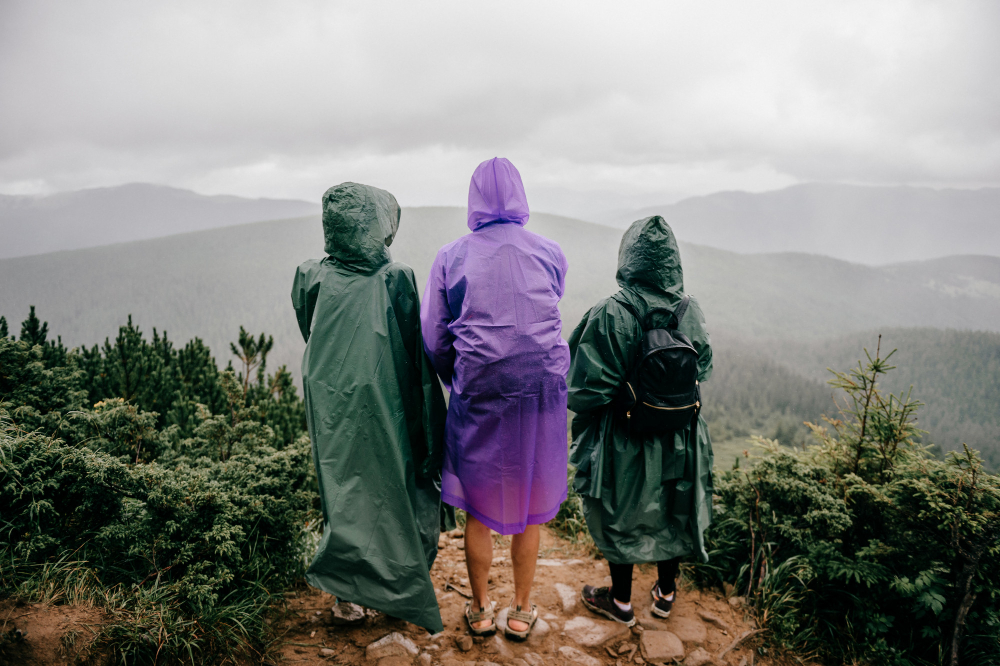
Hiking in the rain can be a surprisingly pleasant experience. The sound of raindrops hitting the ground, the smell of fresh soil, and the feeling of the outdoors create an atmosphere of peace and renewal.
Rain can also create exciting hiking conditions, such as slippery rocks or mud, but this only adds to the challenge and excitement of the trip. Even if you don’t leave the hike dry, you will have a new appreciation for nature and its beauty.
Building a Campfire In The Rain
Building a campfire in the rain while camping can be daunting, but it is possible with proper preparation. You can buy waterproof matches to get the fire started. You will also need dry wood.
First, choose a well-built fire pit protected from rain and wind. Next, collect dry firewood and use a shovel and kindling to help the fire grow.
Cover the fire with a tarp shelter to protect it from the rain.
If the rain is heavier, you may need an extra layer, such as coal or wax, to create enough heat to keep the fire going.
Keep a close eye on the fire to ensure it doesn’t get out of hand, and you can create a warm and cozy campfire even in the rain.
Rainy Day Camping Activities
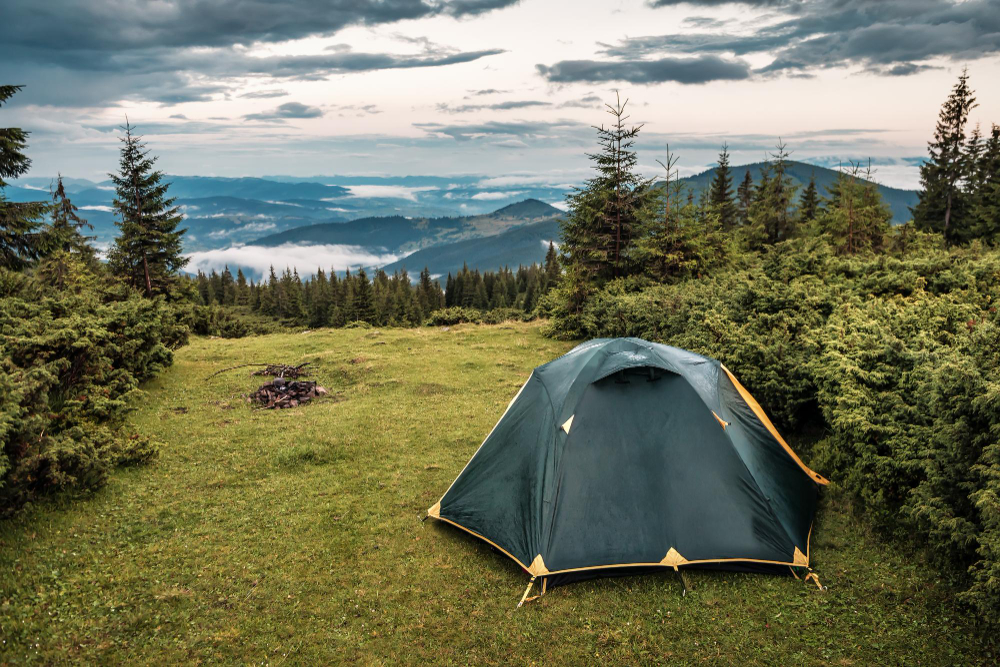
Rainy days don’t have to put a damper on your camping fun, as there are plenty of rainy-day camping activities to enjoy even when the weather isn’t ideal. So, there are still some occupations when it’s raining, and you’re stuck indoors.
For starters, playing cards or board games are a great way to pass the time.
You can also make crafts from any materials you bring or find at camp. If you’re feeling creative, try painting or drawing. But, if you have a culinary spirit, you will find cooking enjoyable.
Explore the environment around you and attract animals that live in the camping area, and make camping enjoyable, such as looking for frogs, insects, birds, and other wildlife that may be present.
You can take the opportunity to read a book from the library or write in a journal about your camping experience.
Remember The Positive Attitude!
We hope you found this article helpful and that you will only have a positive attitude when camping in the rain. A negative mindset can quickly slow down your time outside, so making the most of your time, even in adverse conditions, is essential.
Remember to be grateful for the opportunity to explore nature. So take advantage of the small moments and enjoy what you can do even when it’s rainy.
Pack appropriately, and you’ll be ready for a camping adventure!
Feel free to write your thoughts, experience, and some fun stories in the comments. We would like to hear from you!
-
Milica is a nature lover and explorer of the great outdoors. She is always up for the challenge, whether camping, hiking, kayaking, or cycling. For her, exploring nature is a great way to connect with the environment around us and meet new people along the way. She always looks for the next journey and loves sharing her experiences with others. Besides, she loves writing and thus creates exciting stories based on personal experience.
View all posts




